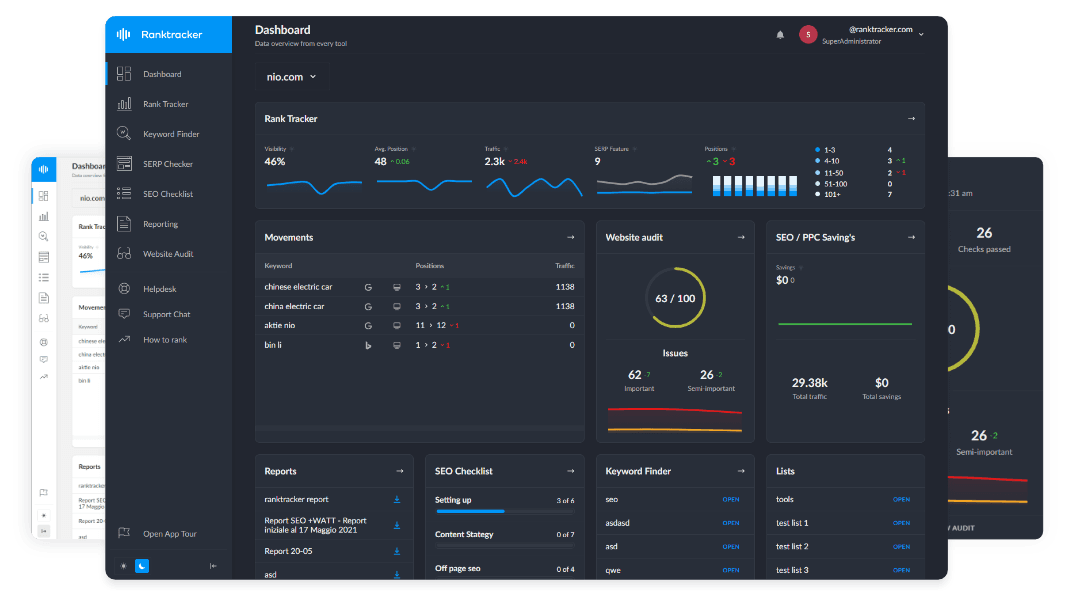Intro
Understanding which keywords your competitors rank for is essential for building a strong SEO strategy. By analyzing competitor keywords, you can:
- Identify gaps in your content strategy.
- Discover new keyword opportunities.
- Understand what’s driving traffic to competing websites.
- Improve your SEO efforts by targeting high-performing keywords.
- Stay ahead of competitors in search rankings.
Best Methods to Find Competitor Keywords
There are multiple ways to discover the keywords your competitors rank for. Here’s how:
1. Using Ranktracker’s Competitor Analysis (Recommended)
Ranktracker’s Competitor Analysis tool allows you to uncover competitor keyword rankings in real time. Here’s how to use it:
- Step 1: Enter your competitor’s domain in Ranktracker’s Competitor Analysis tool.
- Step 2: View a list of all keywords your competitor ranks for.
- Step 3: Analyze search volume, keyword difficulty, and ranking position.
- Step 4: Identify high-traffic keywords and assess ranking opportunities.
- Step 5: Compare competitor keywords to your own and optimize accordingly.
2. Google Search Console (For Your Site Only)
While Google Search Console doesn’t show competitor data, it provides insights into how your own site ranks. You can use this data to compare against competitors.
- Step 1: Log into Google Search Console.
- Step 2: Navigate to Performance > Search Results.
- Step 3: Analyze the keywords your site ranks for and compare them with competitor insights.
3. Google Keyword Planner
Google’s Keyword Planner helps you find competitor-related keywords by researching industry-specific terms.
- Step 1: Go to Google Ads Keyword Planner.
- Step 2: Enter competitor website URLs into the Discover New Keywords tool.
- Step 3: View suggested keywords and compare search volume.
4. Ahrefs (Paid Option)
Ahrefs’ Site Explorer feature provides an in-depth look at competitor keyword rankings.
- Step 1: Enter your competitor’s domain into Ahrefs Site Explorer.
- Step 2: Navigate to the Organic Keywords report.
- Step 3: Filter keywords by position, difficulty, and search volume.
5. SEMrush (Paid Option)
SEMrush’s Organic Research tool is another great way to find competitor keywords.
- Step 1: Enter your competitor’s domain into SEMrush’s Organic Research.
- Step 2: Get a list of ranking keywords, their positions, and estimated traffic.
- Step 3: Identify gaps and create content to outrank competitors.
How to Use Competitor Keywords to Improve Your SEO
Once you’ve identified your competitor’s ranking keywords, you can:
-
Optimize Existing Content:
- Update your pages to include high-traffic keywords.
- Improve meta titles, descriptions, and headings.
- Strengthen internal linking for better keyword authority.
-
Target High-Opportunity Keywords:
- Focus on low-competition, high-search-volume keywords.
- Use Ranktracker’s Keyword Finder to uncover ranking opportunities.
-
Enhance Content Strategy:
- Create in-depth, high-value content based on competitor keyword insights.
- Cover topics your competitors rank for but with better optimization.
-
Build Backlinks to Boost Authority:
- Earn links from relevant, authoritative sites to improve rankings.
- Use Ranktracker’s Backlink Checker to track competitor backlinks.
-
Monitor and Adjust Strategy:
- Keep tracking competitor rankings using Ranktracker’s Rank Tracker.
- Adapt content based on ranking changes and industry trends.
Conclusion
Finding out what keywords your competitor ranks for is essential for refining your SEO strategy. Ranktracker’s Competitor Analysis tool provides the most effective way to track and compare competitor rankings. Other tools like Google Keyword Planner, Ahrefs, and SEMrush can also offer valuable insights.
Want to uncover competitor keyword rankings? Try Ranktracker now and gain an SEO advantage!

